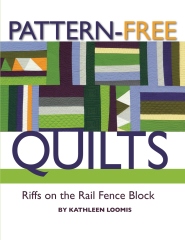In Cincinnati I taught a second workshop last weekend, on curved piecing. I know most people use non-pieced methods to get curved shapes onto their quilts -- fusing, or raw-edge applique, or turned-edge applique, sometimes executed by hand stitching, or by machine zigzag or blanket stitch, sometimes with invisible thread. In many cases I suspect I could get the same curve sewed up with old-fashioned piecing in less time -- and that way I have the perfectly clean, hard-edged line that I love about pieced quilts in general.
I've written before about how to make curved seams that are perfectly controlled, when you want your shapes to look exactly the way you have planned them. But the workshop last weekend concentrated on a less controlled, more serendipitous method of piecing curves. I call it "close enough for government work."
In this method, you simply stack two layers of fabric on top of one another, slice a gentle curve through both layers, then swap the two sides of the cut and sew each piece to the opposite piece of the other color. As long as the curves aren't too tight -- more the profile of a big watermelon than the profile of a grapefruit -- and the fabric isn't too tightly woven, they will sew together and agree to be pressed flat, even though they don't exactly match.
I have used this approach extensively in the past and have always been surprised at how much complexity and sophistication you can achieve with only a handful of cuts. In the workshop, participants cut three panels, two from one color and one from a contrast color. After only five slices, here's the kind of compositions they came up with:
What's exciting about this method is that you never know exactly what you're going to come up with. For some reason it's hard to visualize how the curved shapes are going to align after you've sliced and sewed. If you like to plan ahead and execute your design the way you drew it, this isn't the technique for you. But if you love to be surprised by your own work, this method certainly delivers.









Sounds like great fun.
ReplyDeleteMarti